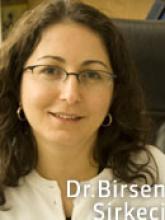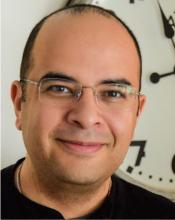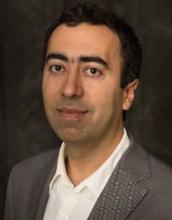Communication and Signal Processing

Dr. Birsen Sirkeci-Mergen
Associate Professor
EE Dept, San Jose State University
Thu, 03/02/2017
Abstract – Wireless communication is progressing at an accelerated speed. Increasing variety of applications and features of wireless devices is leading to demands for higher and higher data rates. However, the bandwidth licensed to radio communication is limited. The infamous question is “How do we get better data rates under limited bandwidth requirements to meet the demand?”. An emerging advanced solution for efficient spectrum utilization is a cognitive radio–a transceiver technology that is capable of, not only sensing the spectrum, but also, monitoring, detecting and adapting its communication. Past decade has seen an explosion of activity in understanding dynamic spectrum allocation in cognitive radio networks. In this talk, we will look at the design and performance of spectrum sensing strategies for cognitive radio networks.
Dr. Birsen Sirkeci is an associate professor in the department of Electrical Engineering at San Jose State University (SJSU), San Jose, CA. She received her Ph.D. from Cornell University, Ithaca, NY in 2006. Prior to joining SJSU, she was a postdoctoral researcher at UC Berkeley, CA. Her main research lies in the areas of wireless communications, sensor networks, statistical signal processing and statistical learning. She received best paper awards in Milcom 2015, WCECS 2010 and ICETEC 2013. She was elected as outstanding organizing committee member of IEEE ICME in 2013. She received the Applied Materials teaching award at SJSU in 2014. She also co-advised SJSU Spartans team which ranked among the finalist in Darpa Spectrum Challenge in 2013.
VCSEL-based Multimode Fiber Optics for Datacenters and Supercomputers

Dr. Brendan Hamel-Bissell
Assistant Professor
ES Dept, SSU
Thu, 02/16/2017
Abstract – High Performance Computing and Data Centers are driving the demand for high bandwidth interconnects. According to Cisco, cloud data center traffic is projected to grow to 8.6 Zettabytes per year, with 73% of that traffic within the data center. Future exascale supercomputers capable of more than a quintillion operations per second will demand higher performance networks characterized by lower power consumption, lower cost, and higher bit rate. VCSEL-based multimode optical links are one key solution to enable this growth. In this talk, I will present three projects to address the demands of future optical links. In the first part, I will describe a 30Gb/s 90nm CMOS-driven multimode optical link that uses equalization to achieve higher data rates and lower power consumption. In the second part, I will describe a 4-channel wavelength division multiplexing solution for uncooled lasers using injection-molded optics to reduce system costs. In the third part, I will describe a system to characterize VCSELs using hyperspectral imaging, and I will show how this system can be used to improve multimode fiber bandwidth from 6.3GHz to 17.5GHz over 300m.
Dr. Brendan Hamel-Bissell is an Assistant Professor at the Department of Engineering, SSU. He grew up in Underhill, Vermont, where he spent most of his time in the mountains skiing, including 6 years on the US National Ski Patrol. He did his undergrad at McGill University in Montréal, Canada, and became interested in the applications of optics, especially optical communications. He completed his PhD in electrical engineering at Stanford University in 2016, with a focus of optical communications in data centers. While at Stanford, he worked with industry researchers as a Senior Scientist at Finisar Corporation and taught electrical engineering at De Anza College. Brendan is passionate about supporting the LGBTQ community; he has served on the Board of Directors of Stanford Pride, Stanford's LGBT alumni association since 2012 and as the Director of Admissions for the Out for Undergrad Engineering Conference since 2014.
Global Technology Supply Chains: What they are and why you need to know about them

Mr. Patrick Harper
VP & General Manager
Technology Supply Chain, Keysight Technologies
Thu, 02/02/2017
Abstract – The Global Technology Supply Chain is an AND world! As electronic instruments and products become more complex, and more prevalent, designers are challenged to design state of the art equipment that is state of the art AND cost competitive AND environmentally responsible. In this lecture we will explore what a global technology supply chain is and how design choices engineers make during the initial product design can be optimized for a cost effective and “greener” global supply chain. We will look at the concept of “Design for Supply Chain.” Design is a series of trade-offs and the design of a supply chain is no different. Various countries around the world have comparative advantage for certain aspects of the supply chain and designers need to be cognizant of these strengths and also the cost, risk, and environmental impact tradeoffs associated with these choices. Finally, we will explore engineering jobs that are needed within the enterprise supply chain function.
Mr. Patrick Harper is the Vice President and General Manager of the Technology Order Fulfillment team at Keysight Technologies. He manages a team of over 1000 employees worldwide and has team members in Germany, Geneva, Spain, UK, Finland, Penang Malaysia and the US. Pat has been in the high tech industry for over 35 years including 20 years with Hewlett Packard and 13 with Agilent Technologies, and two years with Keysight Technologies. He has held a variety of positions in Manufacturing and R&D. He has a BS in Economics and a MS in Project Management from the University of San Francisco and is PMP certified. In his “spare time” he is an adjunct professor at the University of San Francisco and Sonoma State University teaching a variety of undergrad and graduate courses. Pat currently serves on the board of two non-profits and is very involved in STEM programs and projects across Sonoma County.
Sustainable Storage: Approaches to Efficient and Practical Storage Reliability at Scale

Dr. Ahmed Amer
Associate Professor
Department of Computer Engineering, Santa Clara University, Santa Clara, CA
Thu, 11/17/2016
Abstract – Stored data needs to be protected against device failures, irrecoverable read errors, and other risks that become increasingly challenging at scale. At the same time, it is essential to manage underlying storage efficiently, and to do so in the face of incremental and dramatic changes to the underlying storage technologies. In this talk, we will discuss the building of large-scale reliable storage systems, and the problems encountered when employing new storage technologies. In particular we will discuss the problems posed by the recent shift in magnetic disk-based data storage to what is termed shingled magnetic recording (SMR). This shift is an important step in continuing the increase in data storage densities, but it also makes updates to existing data potentially destructive and requires software-based approaches to mitigate this behavior. We will go on to discuss the ways in which future storage systems software can address these challenges efficiently.
Dr. Ahmed Amer is an associate professor of Computer Engineering at Santa Clara University. His research areas are systems, particularly storage systems, operating systems, and distributed systems. His work has included the predictive management of data and storage, with recent work involving data grouping and the management of shingled magnetic recording technologies, the design of highly reliable systems at scale, and energy management. He is especially interested in alternative and upcoming storage technologies, and their most practical and effective application.
Image Comprehension on Mobile and Cloud Platforms

Dr. Soheil Ghiasi
Professor
Electrical and Computer Engineering, UC Davis, Davis, CA
Thu, 11/03/2016
Abstract – Convolutional Neural Networks (CNNs) have led to remarkable breakthroughs in a number of important pattern recognition tasks, such as image and voice recognition. Modern CNNs are composed of many layers, have millions (sometimes billions) of parameters, and require massive amount of computation to train them. The training is typically performed using large amount of data on massively-parallel servers equipped with graphics processing units (GPUs). Subsequently, the trained models are utilized in many application scenarios to run 'inference' on user's data, often on resourceconstrained mobile devices. The computational demand of running modern CNNs creates interesting technical challenges, in particular as it relates to deployment of trained models to resourceconstrained devices, such as smart phones and mobile robots. This talk presents an overview of this emerging area. We will also discuss some ongoing work in our group, where we focus on optimizing CNN inference via custom FPGA-based accelerators or mobile graphics processing units (mobile GPUs).
Dr. Soheil Ghiasi is a professor of electrical and computer engineering at the University of California, Davis. His research interests are design and optimization of embedded systems for signal processing, machine learning and multimedia applications. He received his B.S. degree from Sharif University of Technology, Tehran, Iran in 1998, and his M.S. and Ph.D. in Computer Science from University of California, Los Angeles in 2002 and 2004, respectively. He has served on the organizing and technical program committees of numerous technical conferences, and several journals in the general area of computing systems. He is a senior member of IEEE and ACM.